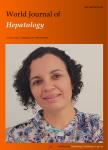Alpha-1 antitrypsin deficiency and the risk of hepatocellular carcinoma in end-stage liver disease
Alpha-1 antitrypsin deficiency and the risk of hepatocellular carcinoma in end-stage liver disease作者机构:Department of Internal MedicineCleveland Clinic Foundation Department of Quantitative Health SciencesCleveland Clinic Foundation Department of Gastroenterology and Hepatology and Digestive Disease InstituteCleveland Clinic Foundation Departments of Pulmonary and Critical CareRespiratory Institute and Education InstituteCleveland Clinic Foundation
出 版 物:《World Journal of Hepatology》 (世界肝病学杂志(英文版)(电子版))
年 卷 期:2015年第7卷第10期
页 面:1427-1432页
学科分类:1002[医学-临床医学] 100214[医学-肿瘤学] 10[医学]
主 题:Hepatocellular carcinoma Liver cirrhosis End-stage liver disease Hepatitis C virus Alpha-1antitrypsin deficiency
摘 要:AIM:To evaluate the association between alpha-1 antitrypsin deficiency(A1ATD) and hepatocellular carcinoma(HCC) in patients with end-stage liver disease(ESLD).METHODS:Patients with cirrhosis and ESLD referred to the Cleveland Clinic Foundation for liver transplantation between 2003 and 2014 were included in the study(N = 675). ESLD was defined as having histological features of cirrhosis and/or radiological evidence of cirrhosis in the context of portal hypertension(ascites,variceal bleeding,thrombocytopenia,or hepatic encephalopathy). A1 ATD was diagnosed using phenotype characterization(MZ or ZZ),liver biopsy detection of PAS-positive diastaseresistant(PAS+) globules,or both. Patients with other causes of liver diseases such as hepatitis C virus(HCV),alcoholic liver disease and non-alcoholic steatohepatitis(NASH) or NASH were also included in the study. HCC was diagnosed by using imaging modalities,biopsy findings,or explanted liver inspection. Follow-up time was defined as the number of years from the diagnosis of cirrhosis to the diagnosis of hepatocellular carcinoma,or from the diagnosis of cirrhosis to the last follow up visit. The rate of HCC was assessed using time-tointerval analysis for interval censored ***:This study included 675 patients. 7% of subjects had A1ATD(n = 47). Out of all subjects who did not have A1 ATD,46% had HCV,17% had alcoholic liver disease,19% had NASH and 18% had another primary diagnosis. Of the 47 subjects with A1 ATD,15 had a primary diagnosis of A1ATD(PI*ZZ phenotype and PAS+ globules),8 had a PI*MZ phenotype alone,14 had PAS+ alone,and 10 had both the PI*MZ phenotype and PAS+. Median follow-up time was 3.4(25th,75 th percentiles:1,5.2) years. The overall rate of hepatocellular carcinoma in all subjects was 29%(n = 199). In the A1 ATD group,the incidence rate of HCC was 8.5% compared to 31% in the group of patients with other causes of cirrhosis(P = 0.001). Patients with ESLD due to A1 ATD had the lowest yearly cumulativ



